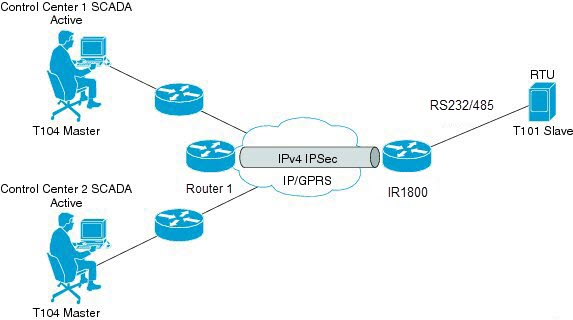Supervisory Control And Data Acquisition (SCADA) Overview
SCADA refers to a control and management system employed in industries such as water management, electric power, and manufacturing. A SCADA system collects data from various types of equipment within the system and forwards that information back to a Control Center for analysis. Generally, individuals located at the Control Center monitor the activity on the SCADA system and intervene when necessary.
The Remote Terminal Unit (RTU) acts as the primary control system within a SCADA system. RTUs are configured to control specific functions within the SCADA system, which can be modified as necessary through a user interface.
On the IR1800, line is 0/2/0 or 0/2/1, same as the Async interface.
Role of the IR1800
In the network, the Control Center always serves as the master in the network when communicating with the IR1800. The IR1800 serves as a proxy master station for the Control Center when it communicates with the RTU.
The IR1800 provides protocol translation to serve as a SCADA gateway to do the following:
-
Receive data from RTUs and relay configuration commands from the Control Center to RTUs.
-
Receive configuration commands from the Control Center and relay RTU data to the Control Center
-
Terminate incoming requests from the Control Center, when an RTU is offline
The IR1800 performs Protocol Translation for the following protocols:
-
IEC 60870 T101 to/from IEC 60870 T104.
-
DNP3 serial to DNP3 IP
Key Terms
The following terms are relevant when you configure the T101 and T104 protocol stacks on the IR1800:
-
Channel–A channel is configured on each IR1800 serial port interface to provide a connection to a single RTU for each IP connection to a remote Control Center. Each connection transports a single T101 (RTU) or T104 (Control Center) protocol stack.
-
Link Address–Refers to the device or station address.
-
Link Mode (Balanced and Unbalanced)–Refers to the modes of data transfer.
-
An Unbalanced setting refers to a data transfer initiated from the master.
-
A Balanced setting can refer to either a master or slave initiated data transfer.
-
-
Sector–Refers to a single RTU within a remote site.
-
Sessions–Represents a single connection to a remote site.
The following terms are relevant when you configure the DNP3 protocol stacks on the on the IR1800:
-
Channel–A channel is configured on the IR1800 serial port interface to provide a connection to a single RTU for each IP connection to a remote Control Center. Each connection transports a single DNP3 serial (RTU) or DNP3 IP (Control Center) protocol stack.
-
Link Address–Refers to the device or station address.
-
Sessions–Represents a single connection to a remote site.
Protocol Translation Application
In Routers Within a SCADA System the IR1800 (installed within a secondary substation of the Utility Network) employs Protocol Translation to provide secure, end-to-end connectivity between Control Centers and RTUs within a SCADA System.
The IR1800 connects to the RTU (subordinate) through a RS232/RS485 connection. To protect the traffic when forwarded over public infrastructures (for example, cellular), the IR1800 forwards SCADA data from the RTU to the Control Center in the SCADA system through an IPSec tunnel (FlexVPN site-to-site or hub and spoke). The IPSec tunnel protects all traffic between the IR1800 and the Head-end aggregation router. SCADA traffic can be inspected through an IPS device positioned in the path of the SCADA traffic before it is forwarded to the proper Control Center.

Prerequisites
RTUs must be configured and operating in the network.
For each RTU that connects to the IR1800, you will need the following information for T101/T104:
-
Channel information
-
Channel name
-
Connection type: serial
-
Link transmission procedure setting: unbalanced or balanced
-
Address field of the link (number expressed in octets)
-
-
Session information
-
Session name
-
Size of common address of Application Service Data Unit (ASDU) (number expressed in octets)
-
Cause of transmission (COT) size (number expressed in octets)
-
Information object address (IOA) size (number expressed in octets)
-
-
Sector information
-
Sector name
-
ASDU address, (number expressed in octets)
-
For each RTU that connects to the IR1800, you will need the following information for DNP3:
-
Channel information
-
Channel name
-
Connection type: serial
-
Link address
-
-
Session information
-
Session name
-
Guidelines and Limitations
-
Each channel supports only one session.
-
Each session supports only one sector.
-
The object types 8, 17, 18, 19, 20, 38, 39, and 40 are not supported for IEC protocol translation.
Default Settings
|
T101/T104 Parameters |
Default |
|---|---|
|
Role for T101 |
Master |
|
Role for T104 |
Slave |
|
DNP3 Parameters |
Default |
|---|---|
|
Unsolicited Response (DNP3-serial) |
Not Enabled |
|
Send Unsolicited Message (DNP3-IP) |
Enabled |

 Feedback
Feedback